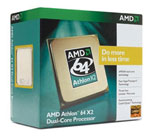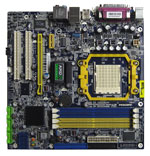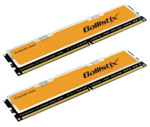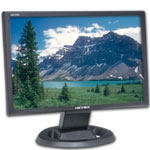AMD Entry-level PC
With few releases for the entry-level AMD market since our last
Budget Buyer's Guide, we have a very similar level of components - albeit with a doubling of RAM that should boost performance nicely in Vista. This boosted performance comes in at $100 cheaper than six months ago as well. Although that may not sound like much to an enthusiast gamer that can spend five times as much on a graphics card, for the budget computer users $100 is a 10% reduction in price. For businesses looking at upgrading hundreds or even thousands of computers, that sort of savings is even more significant, making now a great time to purchase AMD hardware.
| AMD Entry-level PC |
| Hardware |
Component |
Price |
Rebates |
| Processor |
AMD Athlon 64 X2 4000+
(2.1GHz 65W Brisbane 2 x 512KB L2) |
$66 |
- |
| Motherboard |
Foxconn A690GM2MA-8KRS2H
AMD 690G mATX |
$49 |
$20 |
| Memory |
Crucial Ballistix 2GB (2x1GB) DDR2-800 PC2-6400 |
$90 |
$40 |
| Hard Drive |
Samsung Spinpoint P Series SP2504C
250GB 7200RPM SATA 3.0GB/s |
$63 |
- |
| Optical Drive |
Samsung 20X DVDRW/DL SH-S202G |
$28 |
- |
| Case |
Athenatech A3602BB.400 mATX w/400W PSU |
$35 |
- |
| Display |
Hanns-G HW-191DPB Black 19" 5ms Widescreen DVI
(1440x900) |
$170 |
- |
| Speakers |
Logitech R-20 12W 2.1 |
$19 |
- |
| Input |
Microsoft Optical Desktop 1000 Wireless |
$26 |
- |
| Operating System |
Microsoft Vista Home Premium OEM |
$112 |
- |
| Bottom Line |
$658 |
$598 |
 |
Prices on AMD's dual-core processors are continuing to drop in the face of the continued, aggressive pricing strategy adopted by Intel. With the imminent launch of the desktop Phenom processor line, we should see prices bottom out as AMD tries to clear out their existing inventory of processors. The Athlon X2 4000+ is a great little chip for the price, now at around 1/3 the cost of what many paid for their dual-core Athlon chips 18 months ago. With the Athlon X2 3600+ saving us a total of just $3, there really isn't another low-end dual-core option from AMD worth considering.
If money is still a concern, we could drop the processor down to a single-core Athlon 64 3200+ (2.0GHz Orleans core) at $42.99 - a savings of $23. Another option is the Sempron LE-1100 based around AMD's Sparta core, which runs at 1.9GHz, has a power draw of just 45W, and a price of just $39.99 - great for the most basic of office PCs or for those looking to save on power consumption. However, our recommendation would be to spend a bit more on the CPU and go for a dual-core; there's no doubt that these will be a pre-requisite in the next few years as application demands increase.
 |
Choosing a motherboard can be one of the hardest decisions to make when building a new system, and is a particular concern when building within the budget/entry-level range. The theory that budget decreases result in compromised quality simply isn't true anymore - or at least it doesn't need to be the case; there are still some cheap, very poor quality motherboards out there. When building for a budget system, features, reliability, and stability should remain high on the list and the situation is continually improving - die shrinks of CPUs, IGPs, and chipsets all help to keep costs low as performance increases.
For the current situation, the AMD 690G with ATI's Radeon X1250 GPU chipset is still our frontrunner when choosing an entry-level AMD motherboard. The good news is that motherboards based on this chipset - and from reputable manufacturers - are available for under $50. Foxconn is one of the largest OEM suppliers in the world, producing everything from EVGA video cards to Apple MacBook/Pro motherboards and Sony PlayStation 3 mainboards. Their quality control has risen over the last few years and the somewhat long-winded A690GM2MA-8KRS2H has all the features you can find in competing motherboards, all at a significantly lower price.
 |
With DDR2 prices at their lowest point, we went for DDR2-800 this time - and managed to score 2GB of Crucial's high-performance Ballistix RAM for the same price as RAM from budget manufacturers. This particular line of RAM costs more than four times as much just six months ago, and presents an attractive alternative while providing a future-proof selection should you wish to ditch the onboard graphics, purchase a video card, and start gaming seriously. Granted, the $50 price involves a mail-in rebate, but for high-quality RAM it might be worth the hassle. If you prefer to avoid MIRs, nearly every major manufacturer has 2GB kits of DDR2-800 going for ~$50 give or take, so there are plenty of options available.
For the remaining items, we went with Samsung's SpinPoint hard drive series this time as availability has increased since our last roundup. The SpinPoint range is renowned for their reliability and silence, without sacrificing performance. Truth be told, while there are differences between hard drives, outside of running benchmarks most people aren't likely to notice the difference in performance. Western Digital, Seagate, and Hitachi are the other major brands, and all are worthy of consideration if the price is right.
The last major component to discuss is the display, and here we have to choose between standard aspect ratio (4:3) and widescreen (16:9). As far as we're concerned, the sooner 4:3 displays die out, the better.
(Ed: Maybe then EA will finally get with the program and include proper WS support!) Although standard aspect ratio displays have a slightly larger surface area, the quality of budget widescreen displays has risen this past year. With 19" displays regularly selling for under $200 - and usually for no more than a couple of dollars more than 17" displays - this display from Hanns-G represents fantastic value for money.














63 Comments
View All Comments
jtr - Friday, February 1, 2008 - link
Jarred and Jonathan,These buyer's guides are very helpful, especially since you give your rationale and alternatives. I wonder if you could also recommend what you would buy with just $100 more (i.e., what's worth spending a little extra for). Also hoping the next budget buyer's guide is on the horizon--I'm planning on building another rig soon. Thanks, again.
Jason
owend - Tuesday, November 13, 2007 - link
I just completed my budget build on Nov 4th. Reading your article with many of the same components was reaffirming! Similar to the Intel builds mine was a Intel E2140, Gigabyte GA-P35-DS3L, and 2GB of 4-4-4 memory with a $40 MIB (one of the “nearly every major manufacture[s]”). With my sensitive ears I did opt for the $50 passive heatsink from Thermalright and a Corsair power supply, both of which you mentioned. Even the Samsung 20xDVD was the same (but I spent 2.5x $ on a retail <weep>). The only real difference was I used a $60 passively cooled video card, but my focus was the ears and not gaming.I think your article was spot on. I labored for a month researching my build but could have waited another few days and just read your article instead. You present a great budget build from which each individual can tailor to their specific needs. Thanks.
JonathanMaloney - Friday, November 16, 2007 - link
Good to hear that - and thanks for the positive comments :)Cignal - Monday, November 12, 2007 - link
ntJarredWalton - Tuesday, November 13, 2007 - link
We just did a http://www.anandtech.com/guides/showdoc.aspx?i=312...">Midrange Guide a month ago, which is mostly current. You could change out the GPU, obviously, but otherwise the choices are pretty much the same.crazycarl - Friday, November 9, 2007 - link
What exactly does the gigabyte have that the abit does not? Feature comparisons don't show any particular omission from one to the other, and I've heard the abit is a better overclocker, if more finnicky to get going. Can anyone clarify this for me?JarredWalton - Friday, November 9, 2007 - link
Gigabyte has an extra x1 PCI-E slot. Other than that, the difference mainly is the "finickiness" you mention. The abit is a reasonable alternative and there is nothing inherently wrong with either board. Some people love abit, though, and others prefer some other brand.Polizei - Friday, November 9, 2007 - link
After doing a little more research and pondering over the article, I did have a few questions if maybe the article writers could clear things up.1. Were these systems actually tested? Or is this just a conglomeration of parts that you have used in the past in various systems that all seemed to work well. OR, were some of the parts never even used before and just seemed like a good value for the money?
2. I ask the above questions mainly because I was concerned about the Case and Power Supply combos you chose. While those deals always seem tempting, like others, I have heard horror stories regarding the power supplies in these combos and have seen pretty much no reviews for any of the mentioned models. The same rang true with the micro-atx gigabyte board you used in your budget Intel system; I've heard of the AMD one and it has gotten great reviews, but I haven't heard much of anything for the intel one except for a few negetive comments about it's failure to compete with G33 chipset boards. So again I'm just curious if these parts were actually tested.
Again though I'd like to reiterate how appreciative I am that a review team finally stepped up and put together an article like this. I'm sure for the most part it is sound, and I agree with a lot of the part choices (not to mention they leave a lot of room to sub parts in here or their based on personal preference). Additionally, you guys respected various opinions by including both an AMD and Intel platform, while most reviewers would have said to forget about AMD even though they still offer a good value for the buck at certain price levels.
JarredWalton - Friday, November 9, 2007 - link
Gary has been working on testing the GB motherboard, and he was a major contributor in terms of the mobo recommendations. Most of the rest, brand isn't particularly important. So the motherboards are solid, according to Gary.For the case and PSU, that's always a huge concern for the elite people out there running midrange and high-end setups. We're talking budget rigs here, folks - though the gaming systems are of necessity closer to midrange than budget.
Are the PSUs in either case great? Not at all. Could the PSU fail at some point? Yup. Overclock a lot and you almost guarantee it will fail. That said, power supplies really aren't a critical factor on low-end systems. Sure, these are rated at 400W, and if we put that sort of load on these models they would almost certainly have problems. (I don't even want to think of seeing Christoph test some of these!) But let's call it a 65% efficiency PSU - reasonable given these are practically free. Power draw on systems like this is going to be around 150W-200W; if you really try, maybe you can get it up to 250W (without overclocking). 250W would mean that the PSU is actually delivering ~160W to the internal components, well within the capacity of even a crappy low-end unit.
I've had OCZ, Enermax, Antec, and various other brands fail on me - almost as often as the completely generic stuff fails. As someone above pointed out, I would be interested to see what sort of compromises people are willing to make to get a good quality $60 PSU into these systems. Or do we just forget about "budget gaming" and stick with midrange systems that cost $1250? We're already over the $1000 I would have liked (and $500 on the entry-level stuff).
Want to post alternatives? Think you can come up with something significantly better that no one will have issues with? Hey, I've built a lot of PCs for people over the years. Fact of the matter is, I still don't know how to get someone shooting for a $500 PC to actually buy a decent power supply! I usually tell them, "if the power supply fails - perhaps even WHEN it fails - you'll have to buy a new one." (Note: I don't run a shop, so this is just helping people out with building a system.)
Polizei - Monday, November 12, 2007 - link
Thank you, I'm glad you took the time to respond to my questions. I realize you guys are trying to put together a good low-budget guide so that people can enjoy big-time performance on a small dollar, and this is necessary in the marketplace.I disagree a great deal with some of your points however. First off, it's clearly apparent from what you said that you guys didn't actually build these budget rigs and test them for part compatibility. It sounds like you've tested many of them independently, but not together, so you're basically trusting paper specs in terms of whether or not the parts actually work together. While that can work most of the time, there's so many finicky parts out there (i.e. motherboards and ram modules not liking each other, videocards not being recognized properly) that if an article like this is going to be done, you should at least put a disclaimer that the rig was not tested as a whole.
Secondly, one of the issues you bring up about PSUs is a valid point; no matter what the company and the efficiency rating, a PSU can fail at random. I too have owned many PSUs over the year from big name companies and small no-name companies, and have had failures on both, but I'd like to say that the bigger names and supplies that review sites have ran through brutal torture tests are likely to hold up better. Do most of these cost more and make a budget rig difficult to fit in? Certainly, but there are still some that are slightly better than others for $50 or less. On top of that, you mention that these parts won't hit a full 400 watt, and while that's correct, I think the 8800 GT (even being a single slot, 104W TDP rated) will possibly up it a little higher then your estimations. Still, it should be more then enough, but if your going to stay cheap, might as well get a lower-wattage PSU from a bigger brand (i.e. a 360W PC Power and Cooling, or a 420W Thermaltake, or a 380W Antec) for a similar or slightly higher price.
Furthermore, the tone of your response (and maybe I'm misinterpreting this) is that a power supply or a power supply failing is unimportant in a budget rig. I'm sorry but this is a ridiculous notion if this is indeed what you meant. Just because someone doesn't have as much money to spend on a rig, it doesn't mean they have to worry about a much higher chance of failure with their hard-earned money. It's true you get what you pay for, but it's still important to look at quality issues, numbers of owners who have had failed units, etc etc as best you can.
Lastly, you mentioned to post something reasonable for the $$. I unfortunately am not a reviewer and also on a low budget, so I too did not have a chance to test this configuration, but this is just another possibility (again hasn't been tested so it's possibly just as good as yours)- (prices from newegg)
Samsung SATA 18x lightscribe DVDR burner|Coolermaster Elite 330 RC-330-KKN1-GP|Western Digital WD800JD SATA 3.0, 7,200rpm, 80GB| ASUS M2A-VM AM2 AMD 690G Micro-ATX|Coolermaster eXtreme RP-500-PCAR 500W|A-DATA 2GB (2 x 1GB) DDR2 800 (PC2 6400)|AMD Athlon 64 X2 4000+ Brisbane 2.1GHz AM2 65W|Sapphire Radeon HD 2600XT 256MB
+ keyboard, speakers, mouse, $550-570. Add Vista, $650-670. (you could do this with intel as well - also you never mentioned if you guys or "Gary" tested that intel board, I was curious about that).
But anyways, I'm not trying to tear you guys or the article apart. I'm definitely a big fan of anandtech.com , I just wanted to see what all was put into the article because parts of it were vague, but you've been helpful in clearing some of it up.